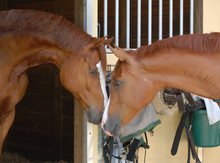Kevin Cox, DVM, Staff Veterinarian/Animal Health Manager, for the Tennessee Farmers Cooperative has some excellent tips for horse owners about how to prevent the risk of spreading the EHV-1 virus which is more prevalent in the spring and summer months when horse travel and comingling are at their peak.

Possible cause EHV-1 - Nose to nose contact
The best defense against EHV-1 and other infectious diseases in horses is stringent biosecurity by taking the necessary steps to prevent infection and/or stop the spread of an infection.
EHV-1 is a highly contagious diseases and few treatment options are available for this viral disease. Supportive care is usually the main therapy.
EHV-1 is known to cause four syndromes:
- Respiratory,
- Abortion,
- Weak foal syndrome,
- The neurologic form which is known as equine herpes myeloencephalopathy
The neurologic form is very serious and can be fatal. Vaccine products are available for all forms of EHV-1 except the neurologic form.
Currently, there are no vaccines labeled to protect against EHM and while it is not 100% fatal, there is no specific treatment and care is purely supportive. Anti-viral drugs may be somewhat successful if used after infection with EHV-1 but before neurological symptoms develop.
Most infections of EHV-1 occur by either direct contact between infected horses including nose to nose contact or indirect contact that allows for the virus particles to be transferred between an infected horse and a healthy horse. while indirect transmission via the air is possible, it is not as common as transference via contact. since indirect contact via a physical object that âcarriesâ the virus is a significant means of transmission,
It is important to be very careful about any items that are used on or around an infected horse. this includes any feeding items, grooming tools, and tack. it is generally a good idea to not share these items with horses that are not from the same premise but especially so when there is concern of an eHv-1 outbreak.
The best defense against this particular virus is stringent biosecurity. Biosecurity is simply the process of taking the necessary steps to prevent an infection and/or stop the spread of an infection. while biosecurity is always important, it is critical during times of outbreaks of diseases. Although biosecurity practices can sometimes seem tedious and somewhat unnecessary, these steps break the cycle of the disease.
The good news is that the EHV-1 virus is easily killed by disinfectants. During times of concern of an outbreak, special vigilance to disinfecting items used for suspect horses is highly recommended.
Nolvasan and Roccal-D are two disinfectants that are commercially available and are extremely effective against the virus. Clorox is also highly effective at killing the virus; it can be mixed at one part bleach to ten parts water and used to disinfect everything from tack to grooming items to stalls and feeding/water buckets.
Gloves should be worn when handling disinfectants. remember that disinfectants are not effective in the face of large amounts of organic debris (dirt or manure), so clean items thoroughly with a soapy solution, rinse, and then disinfect. trailers should also be considered during the disinfectant process.
Sound animal husbandry procedures also apply to preventing the spread of the disease, since the virus is easily spread on physical items, including clothing and hands. It is a good idea to change clothes and wash hands thoroughly between horses if there is a suspect case of EHV-1 Also, any horses that are suspected or have been diagnosed with EHV-1 should be handled last.
Handling sick horses first and then taking care of other horses is an ideal way to spread the virus. Symptoms of EHV-1 include anorexia, a high fever, and possibly a respiratory infection. Horses may show signs of a mild respiratory infection and develop the more serious neurologic symptoms several days later.
Those neurologic symptoms may include a decrease in tone in the rectum, incontinence, weakness in legs that usually starts in hind limbs, and recumbency. Horses showing any of these symptoms should be checked by your local veterinarian to insure further contagion of other horses and to begin effective supportive treatment.
Read more about Biosecurity and EVH-1
